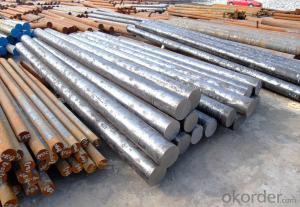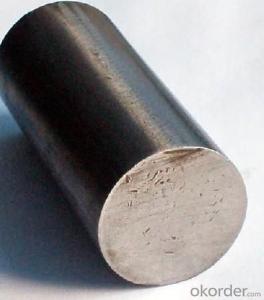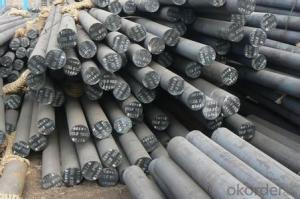1Cr18Mn8Ni5N202 Stainless High Quality Tool Steel
- Loading Port:
- China main port
- Payment Terms:
- TT or LC
- Min Order Qty:
- 25 m.t.
- Supply Capability:
- 10000 m.t./month
OKorder Service Pledge
OKorder Financial Service
You Might Also Like
Product Description:
OKorder is offering Tool Steel at great prices with worldwide shipping. Our supplier is a world-class manufacturer of steel, with our products utilized the world over. OKorder annually supplies products to European, North American and Asian markets. We provide quotations within 24 hours of receiving an inquiry and guarantee competitive prices.
Product Applications:
High Quality Bearing steel is used for manufacturing ball, roller bearing steel and rings. Bearing in work is under great pressure and friction, so have high demands bearing steel and hardness and resistance, and high elastic limit.
Bearing steels are used for ball and roller bearing applications and are comprised of low carbon steels and high carbon through harden able steel.
For example, bearing ring, steel rolling mill, machinery, 100Cr6 bearing steel ball is widely used in high-speed and low-noise bearing, bicycle, motorcycle, automobile, bags electronically.
Product Advantages:
OKorder's Tool Steel are durable, strong, and resist corrosion.
Main Product Features:
· Premium quality
· Prompt delivery & seaworthy packing (30 days after receiving deposit)
· Corrosion resistance
· Can be recycled and reused
· Mill test certification
· Professional Service
· Competitive pricing
Product Specifications:
Grade | bearing steel EN-31 |
Dimensions | Diameter: 20-280mm Length: 2000-5800mm |
Shape | Round Bar |
Type | High chromium bearing steel |
HBS | <220< span=""> |
Standard | AISI |
Technique | Hot Rolled |
Chemical Composition of High Quality Bearing Steel
C | S | P | Si | Mn |
0.95-1.05 | ≤0.025 | ≤0.025 | 0.15-0.35 | 0.25-0.45 |
Cr | Mo | Ni | Cu | Ni+Cu |
1.40-1.65 | ≤0.10 | ≤0.30 | ≤0.25 | ≤0.50 |
Note of High Quality Bearing Steel
1. According to national standard (GB) for our products, if not, supply according to national standards (GB) or agreement.
2. We can not only provide electric furnace +LF+VD and electros lag re-melting (ESR) steel forging materials, but also forging products of piece, bar, etc.
3. Our company is equipped with roll equipment and can provide our customers with roll billets or finished.
4. The materials that we purchase are all accord with International General Standard; you could check it out on the Material Quality Sheet.
5. We are the creator of the “seven-step inspect method” in China.
FAQ:
Q1: Why buy Materials & Equipment from OKorder.com?
A1: All products offered byOKorder.com are carefully selected from China's most reliable manufacturing enterprises. Through its ISO certifications, OKorder.com adheres to the highest standards and a commitment to supply chain safety and customer satisfaction.
Q2: How do we guarantee the quality of our products?
A2: We have established an advanced quality management system which conducts strict quality tests at every step, from raw materials to the final product. At the same time, we provide extensive follow-up service assurances as required.
Q3: How soon can we receive the product after purchase?
A3: Within three days of placing an order, we will begin production. The specific shipping date is dependent upon international and government factors, but is typically 7 to 10 workdays.
Images:
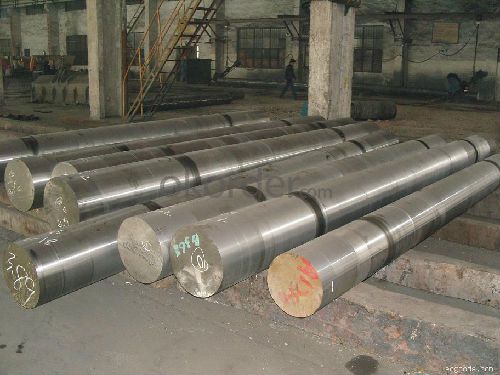
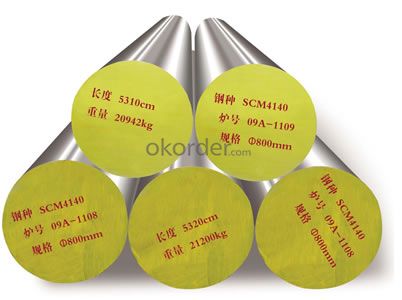
- Q:What is the difference between a hot rolled and a cold drawn steel round bar?
- Hot rolled and cold drawn steel round bars differ primarily in their production methods and resulting characteristics. Hot rolled bars are created by heating a billet or ingot to high temperatures and shaping it through rolling, resulting in a rough, scaled surface with rounded edges. This process allows for quick and efficient production of larger sizes and quantities, however, the steel is less precise in terms of dimensions and has a lower surface finish quality compared to cold drawn steel. In contrast, cold drawn steel round bars are produced by pulling a hot rolled bar through a die at room temperature, resulting in a smooth, polished surface with tighter dimensional tolerances. This process enhances the mechanical properties of the steel, such as improved strength, hardness, and dimensional accuracy. Cold drawing also provides a better surface finish and closer dimensional control compared to hot rolling. Hot rolled steel round bars are often used in construction, manufacturing, and general fabrication due to their lower cost and ease of production. They are suitable for applications where precision and surface finish are not critical factors. On the other hand, cold drawn steel round bars are commonly used in demanding applications that require superior dimensional accuracy, surface finish, and mechanical properties. They are frequently utilized in automotive, aerospace, and machinery industries, where precision and quality are essential. In conclusion, the main disparities between hot rolled and cold drawn steel round bars lie in their production process, resulting surface finish, dimensional accuracy, and mechanical properties. The choice between the two depends on the specific requirements and applications of the steel.
- Q:Can steel round bars be used for making molds?
- No, steel round bars are not typically used for making molds. Molds are usually made from materials such as silicone, rubber, or various types of plastics that can easily be molded and shaped to create the desired form. Steel round bars are better suited for structural purposes or as support rods.
- Q:What are the advantages of using non-alloy steel round bars?
- There are several advantages of using non-alloy steel round bars. Firstly, non-alloy steel round bars are known for their high strength and durability. They have a higher tensile strength compared to alloy steel, making them suitable for various applications where strength is a crucial requirement. This makes them ideal for use in industries such as construction, automotive, and manufacturing. Additionally, non-alloy steel round bars have excellent weldability and machinability. They can be easily welded and formed into various shapes, allowing for flexibility in design and fabrication. This makes them convenient to work with and saves time and effort during the manufacturing process. Non-alloy steel round bars also have good corrosion resistance properties. They are less prone to rust and degradation, making them suitable for use in environments where exposure to moisture or corrosive substances is a concern. This corrosion resistance ensures the longevity and reliability of the steel bars, reducing maintenance and replacement costs in the long run. Furthermore, non-alloy steel round bars are cost-effective compared to alloy steel. They are more affordable and readily available, making them a cost-efficient choice for a wide range of applications. This affordability makes non-alloy steel round bars a popular choice for small-scale projects or businesses with budget constraints. Overall, the advantages of using non-alloy steel round bars include high strength, excellent weldability and machinability, good corrosion resistance, and cost-effectiveness. These qualities make them a versatile and reliable option for various industries and applications.
- Q:How is the copper wire and galvanized round steel connected during the construction of the lightning protection device?
- Generally, the lightning protection devices of buildings are divided into two major categories: external lightning protection devices and internal lightning protection devices. The external lightning protection device consists of a lightning receiver, a lead off line and a grounding device, namely the traditional lightning protection device. Internal lightning protection device is mainly used to reduce the lightning current inside the building and electromagnetic effects, such as the use of electromagnetic shielding, equipotential connection and installation of surge protection device (SPD) and other measures to prevent the harm caused by lightning electromagnetic pulse.
- Q:What are the different finishes available for steel round bars?
- Steel round bars are available in several finishes, each serving a specific purpose and offering distinct benefits. Some commonly used finishes include: 1. Hot Rolled: By heating the steel above its recrystallization temperature and rapidly cooling it, a rough and scaly surface texture is achieved. This finish provides excellent corrosion resistance and durability. 2. Cold Rolled: The steel is rolled at room temperature, resulting in a smooth and polished finish. Cold rolled steel round bars are known for their precise dimensions, tight tolerances, and improved surface finish. 3. Bright Drawn: This finish involves subjecting the steel round bars to a drawing process, where they are pulled through a die to achieve the desired shape and size. It leaves the surface smooth, bright, and free from imperfections. 4. Polished: Polishing is typically done after cold rolling or drawing the steel round bars. Abrasive materials or chemical treatments are used to remove surface imperfections and create a highly reflective finish. Polished steel round bars are commonly used for decorative purposes. 5. Ground: Grinding is a process where abrasive wheels are used to remove surface imperfections or irregularities from the steel round bars. This results in a smooth and even finish, making the bars suitable for applications requiring tight tolerances and uniformity. 6. Galvanized: Galvanizing involves dipping the steel round bars in a bath of molten zinc, creating a protective layer that prevents corrosion and increases their lifespan. This finish is ideal for outdoor applications or environments with high humidity or moisture. These various finishes offer different properties and appearances, allowing steel round bars to be used in industries such as construction, automotive, manufacturing, and engineering. It is important to consider the specific requirements and conditions of the intended use when selecting the appropriate finish for steel round bars.
- Q:What is the maximum weight capacity of a steel round bar?
- The maximum weight a steel round bar can hold depends on several factors, including its diameter, length, grade, and type of steel. Steel round bars are available in various sizes and grades, each with its own load-bearing capacity. To determine the maximum weight a steel round bar can handle, you need to calculate its cross-sectional area using the formula: Area = π * (diameter/2)^2. Here, π represents a mathematical constant that is approximately equal to 3.14159. Once you have the cross-sectional area, you can estimate the weight of the bar by multiplying it with the density of the specific steel grade. The density of steel varies based on the grade, but as a general approximation, it is around 7850 kilograms per cubic meter (or 0.00785 grams per millimeter cubed). However, it's important to remember that weight capacity alone may not be the only factor to consider for the safe use of a steel round bar. Other factors like load distribution, applied forces, and the structural integrity of the bar are equally important to ensure safe operation. For accurate weight capacity information for a specific steel round bar, it is recommended to refer to the manufacturer's specifications or consult a qualified engineer or professional who can provide precise calculations based on the specific requirements and characteristics of the steel round bar in question.
- Q:What is the difference between a bright and a cold finished steel round bar?
- A bright steel round bar refers to a steel bar that has undergone a process called bright drawing, which involves passing the bar through a series of dies to achieve a smooth and shiny surface finish. On the other hand, a cold finished steel round bar is produced by cold drawing, which involves pulling the bar through a die to reduce its diameter and improve its dimensional accuracy. The cold finishing process does not result in a bright and shiny surface like bright drawing does, but it enhances the mechanical properties and overall quality of the bar.
- Q:How do you calculate the moment of inertia for a steel round bar?
- To calculate the moment of inertia for a steel round bar, you can use the formula for the moment of inertia of a solid cylinder. The moment of inertia, usually denoted as I, represents the resistance of an object to changes in its rotation. The formula for the moment of inertia of a solid cylinder is: I = (1/2) * m * r^2 Where: - I is the moment of inertia - m is the mass of the cylinder - r is the radius of the cylinder To calculate the moment of inertia for a steel round bar, you need to know the mass and the radius of the bar. The mass can be determined by multiplying the density of steel by the volume of the cylinder. The volume of a cylinder is given by the formula: V = π * r^2 * h Where: - V is the volume - r is the radius - h is the height or length of the round bar Once you have the mass and the radius, you can substitute these values into the formula for the moment of inertia to calculate it. Remember to convert the units to be consistent (e.g., if the radius is given in centimeters, convert it to meters). It is important to note that the moment of inertia calculated using this formula assumes that the steel round bar is a solid cylinder. If the bar has a different shape or has hollow sections, you will need to consider those factors in your calculation.
- Q:How to determine the welding seam height of steel plate and steel bar?
- If the arc surface in the length direction of the steel bar is lapped welded with the steel plate surface, the gap between the steel plate and the round bar is welded by the 2 side welding angle, so that the welded meat is equal to the largest diameter of the round steel arc surface.
- Q:Can steel round bars be used for making bicycle frames or handlebars?
- Yes, steel round bars can be used for making bicycle frames or handlebars. Steel is a commonly used material in the manufacturing of bicycle frames and handlebars due to its strength, durability, and ability to absorb vibrations. Steel round bars provide the necessary structural integrity and rigidity required for these components, making them suitable for use in bicycle frames and handlebars.
1. Manufacturer Overview |
|
|---|---|
| Location | |
| Year Established | |
| Annual Output Value | |
| Main Markets | |
| Company Certifications | |
2. Manufacturer Certificates |
|
|---|---|
| a) Certification Name | |
| Range | |
| Reference | |
| Validity Period | |
3. Manufacturer Capability |
|
|---|---|
| a)Trade Capacity | |
| Nearest Port | |
| Export Percentage | |
| No.of Employees in Trade Department | |
| Language Spoken: | |
| b)Factory Information | |
| Factory Size: | |
| No. of Production Lines | |
| Contract Manufacturing | |
| Product Price Range | |
Send your message to us
1Cr18Mn8Ni5N202 Stainless High Quality Tool Steel
- Loading Port:
- China main port
- Payment Terms:
- TT or LC
- Min Order Qty:
- 25 m.t.
- Supply Capability:
- 10000 m.t./month
OKorder Service Pledge
OKorder Financial Service
Similar products
New products
Hot products
Related keywords
